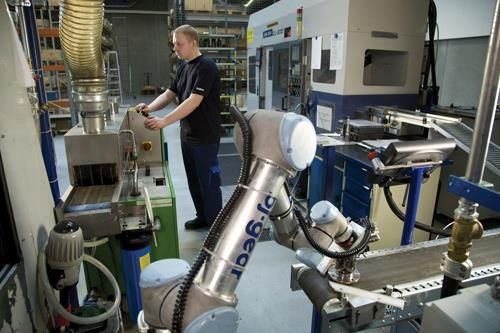Improving Automation with Collaborative Robots
Learn more about collaborative robots, which are designed to ease the transition to automation by working directly alongside employees, with no need for safety caging.
#Industry40

The average person outside of manufacturing generally envisions robots either as large and awkward mechanical structures safely removed from assembly line personnel or futuristic, human-like helpers that handle daily chores with little supervision. Today, robots tend to fall somewhere between those two concepts. The new class of robots known as collaborative robots are designed to work directly alongside employees, with no need for safety caging.
Earlier this year in our March issue, we covered this “robotics revolution” in a feature article that explained their benefits in helping shops move more intuitively towards automation. Read “Collaborative Robots for DIY Automation” for a closer look at ways to bridge the gap between manual assembly and fully automated manufacturing lines.
For an example of a shop putting this technology to use, read “Collaborative Robots Cut Crown Production Time.” This manufacturer of dental implants is realizing faster turnaround time for crowns by using collaborative robots to tend its machine tools.
RELATED CONTENT
-
Handling Parts In A Robotic Cell
Here’s a review of the workholding and workhandling challenges a shop faces as it moves a part through a robotic cell, from serving up the blanks to the transfer of the final workpiece to post processing and gaging. Productivity, Inc. takes the reader through a few of their cells that they've installed using Fanuc robots and a variety of other machine tool equipment.
-
Automation in High-Mix, Low-Volume Turning Applications
Turning shops are familiar with automation for high-volume work, but the shifting landscape to smaller batch sizes has created new challenges.
-
Making Waves with Lathe Automation
After years of relying on an extensive machining cell for part production, this marine equipment manufacturer has now reduced part handling and improved quality through use of single-setup lathes and automated loading and unloading.



